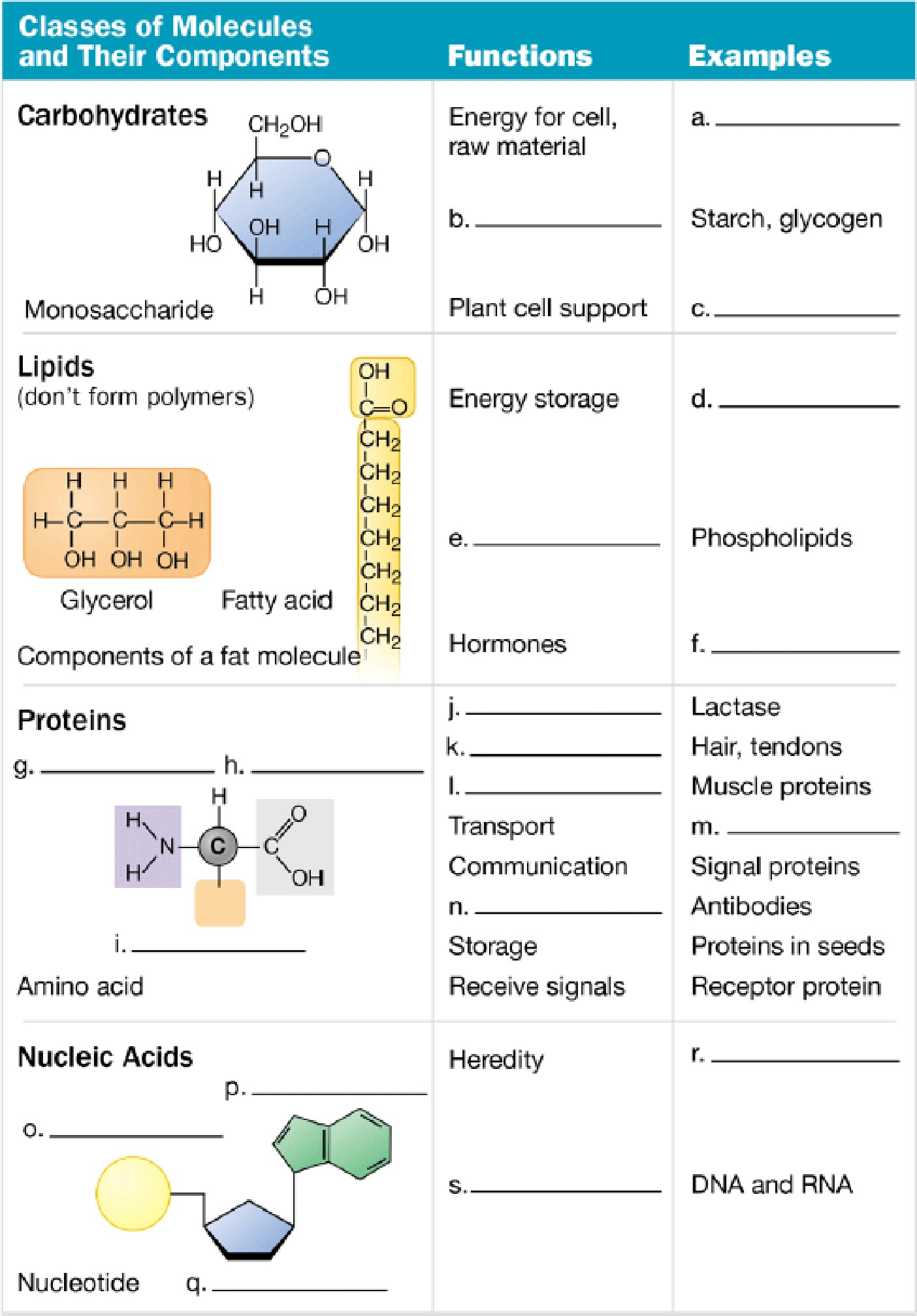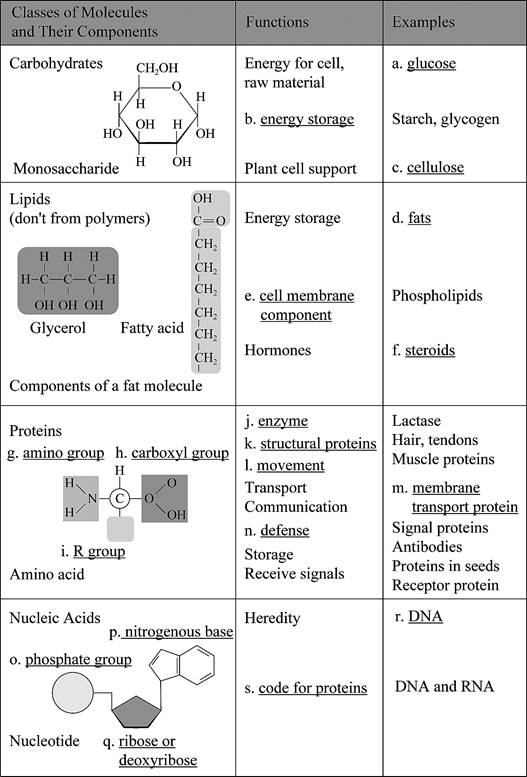
Concept explainers
Complete the following table to help you review the structures and functions of the four classes of organic molecules.

To create: The concept map to review the structures and functions of the four classes of organic molecules.
Introduction: The four classes of molecules such as carbohydrates, lipids, proteins, and nucleic acids are important to sustain the life. Carbohydrates serve as a fuel and building material for cellsand tissues. Lipid comprises a diverse group of molecules. It does not mix with water. A protein is a polymer of amino acids. It is structurally and functionally most complex and varied. Nucleic acid is the genetic material that consists of a polynucleotide.
Answer to Problem 1CC
Pictorial representation: Fig. 1 shows the completed concept map of structures and functions of the four classes of organic molecules.

Fig.1: Concept map of the structures and functions of the four classes of organic molecules.
Explanation of Solution
a.
Correct answer: Glucose
Explanation: Glucose is the raw material from which cell will get energy. Hence, the correct answer is Glucose.
b.
Correct answer: Energy storage
Explanation: The starch and glycogen is used as storage material of energy. Hence, the correct answer is energy storage.
c.
Correct answer: Cellulose
Explanation: Cellulose is polysaccharides which is a polymer of glucose molecule. Hence, the correct answer is cellulose.
d.
Correct answer: Fats
Explanation: Fats are a type of lipid. It is composed of glycerol and fatty acids. Hence, the correct answer is fats.
e.
Correct answer: Cell membrane component
Explanation: Cell is the outermost boundary of animal cell. It is made of phospholipid bilayer. Hence, the correct answer is cell membrane component.
f.
Correct answer: Steroids
Explanation: Steroids are hormones such as estrogen. Hence, the correct answer is steroids.
g.
Correct answer: Amino group
Explanation: Protein is made of amino acids. An amino acid contains amino group which is
h.
Correct answer: Carboxylic group
Explanation: Protein is made of amino acids. An amino acid contains carboxylic group which is
i.
Correct answer: R group
Explanation: Protein is made of amino acids. An amino acid contains a side group which is called R group. Hence, the correct answer is R group.
j.
Correct answer: Enzyme
Explanation: Proteins have broad functions such as enzymes, structural proteins, transport, movement, defense, and storage. Lactase is an enzyme used for breakdown of lactose molecule. Hence, the correct answer is Enzyme.
k.
Correct answer: Structural proteins
Explanation: Proteins have broad functions such as enzymes, structural proteins, transport, movement, defense, and storage. Hair and tendons are structural proteins. Hence, the correct answer is structural proteins.
l.
Correct answer: Movement
Explanation: Muscle is a protein that helps in movement. Hence, the correct answer is movement.
m.
Correct answer: Membrane transport protein
Explanation: Membrane transport protein helps in transport of different molecules across the membrane. Hence, the correct answer is Membrane transport protein.
n.
Correct answer: Defense
Explanation: Signal protein helps in communication. Antibodies are immunoglobulin protein that helps in body defense. Hence, the correct answer is defense.
o.
Correct answer: Phosphate group
Explanation: Nucleic acid is a polymer of nucleotides. A nucleotide consists of phosphate group, sugar and nitrogenous base. Hence, the correct answer is phosphate group.
p.
Correct answer: Nitrogenous base
Explanation: Nucleic acid is a polymer of nucleotides. A nucleotide consists of phosphate group, sugar and nitrogenous base. Hence, the correct answer is nitrogenous base.
q.
Correct answer: Ribose or deoxyribose
Explanation: Nucleic acid is a polymer of nucleotides. A nucleotide consists of phosphate group, sugar (ribose or deoxyribose) and nitrogenous base. Hence, the correct answer is ribose or deoxyribose.
r.
Correct answer: DNA
Explanation: Nucleic acid is a polymer of nucleotides. DNA (deoxyribonucleic acid) is the hereditary material. Hence, the correct answer is DNA.
s.
Correct answer: Code for protein
Explanation: Nucleic acid is a polymer of nucleotides. DNA and RNA have information to code for protein. Hence, the correct answer is code for protein.
Want to see more full solutions like this?
Chapter 3 Solutions
Campbell Biology: Concepts & Connections (8th Edition)
- Molecular Biology Please help. Thank you. Discuss/define the following:(a) poly A polymerase (b) trans-splicing (c) operonarrow_forwardMolecular Biology Please help with question. Thank you in advance. Discuss, compare and contrast the structure of promoters inprokaryotes and eukaryotes.arrow_forwardMolecular Biology Please help with question. Thank you You are studying the expression of the lac operon. You have isolated mutants as described below. In the absence of glucose, explain/describe what would happen, for each mutant, to the expression of the lac operon when you add lactose AND what would happen when the bacteria has used up all of the lactose (if the mutant is able to use lactose).1. Mutations in the lac repressor gene that would prevent the binding of lactose2. Mutations in the lac repressor gene that would prevent release of lactose once lactose hadbound3. Normally the lac repressor gene is located next to (a few hundred base pairs) and upstreamfrom the lac operon. Mutations in the lac repressor gene that move the lac repressor gene 100,000base pairs downstream.4. Mutations in the lac operator that would prevent binding of lac repressorarrow_forward
- You have returned to college to become a phylogeneticist. One of the first things you wish to do is determine how mammals, birds, and reptiles are related. Like any good scientist, you need to consider all available data objectively and without a preconceived “correct” answer. In pursuit of that, you should produce a phylogenetic tree based only on morphological features that show birds and mammals are more closely related. You will then produce a totally different tree, also using morphological features, that shows birds and reptiles are more closely related. Do not forget to include all three groups in both your trees. Based solely off the trees you produce, which relationship would you consider the more likely and why? Once you have answered that question, provide a brief summary of the “modern” understanding of the relationship between these three groups.arrow_forwardtrue or false, the reason geckos can walk on walls is hydrogen bonding between their foot pads and the moisture on the wall.arrow_forwardBiology laboratory problem Please help. thank you You have 20 ul of DNA solution and 6X DNA loading buffer solution. You have to mix your DNA solution and DNA loading buffer before load DNA in an agarose gel. The concentration of the DNA loading buffer must be 1X in the DNA and DNA-loading buffer mixture after you mix them. For that, I will add _____ ul of 6X loading buffer to the 20 ul DNA solution.arrow_forward
- Biology lab problem To make 20 ul of 5 mM MgCl2 solution using 50 mM MgCl2 stock solution and distilled water, I will mix ________ ul of 50 mM MgCl2 solution and ________ ul of distilled water. Please help . Thank youarrow_forwardBiology Please help. Thank you. Biology laboratory question You need 50 ml of 1% (w/v) agarose gel. Agarose is a powder. How would you make it? You can ignore the volume of agarose powder. Don't forget the unit.TBE buffer is used to make an agarose gel, not distilled water. I will add _______ of agarose powder into 50 ml of distilled water (final 50 ml).arrow_forwardAn urgent care center experienced the average patient admissions shown in the Table below during the weeks from the first week of December through the second week of April. Week Average Daily Admissions 1-Dec 11 2-Dec 14 3-Dec 17 4-Dec 15 1-Jan 12 2-Jan 11 3-Jan 9 4-Jan 9 1-Feb 12 2-Feb 8 3-Feb 13 4-Feb 11 1-Mar 15 2-Mar 17 3-Mar 14 4-Mar 19 5-Mar 13 1-Apr 17 2-Apr 13 Forecast admissions for the periods from the first week of December through the second week of April. Compare the forecast admissions to the actual admissions; What do you conclude?arrow_forward
- Analyze the effectiveness of the a drug treatment program based on the needs of 18-65 year olds who are in need of treatment by critically describing 4 things in the program is doing effectively and 4 things the program needs some improvement.arrow_forwardI have the first half finished... just need the bottom half.arrow_forward13. Practice Calculations: 3 colonies were suspended in the following dilution series and then a viable plate count and microscope count was performed. Calculate IDF's, TDF's and then calculate the CFU/mL in each tube by both methods. Finally calculate the cells in 1 colony by both methods. Show all of your calculations in the space provided on the following pages. 3 colonies 56 cells 10 μL 10 μL 100 μL 500 με m OS A B D 5.0 mL 990 με 990 με 900 με 500 μL EN 2 100 με 100 μL 118 colonies 12 coloniesarrow_forward
 Biology Today and Tomorrow without Physiology (Mi...BiologyISBN:9781305117396Author:Cecie Starr, Christine Evers, Lisa StarrPublisher:Cengage Learning
Biology Today and Tomorrow without Physiology (Mi...BiologyISBN:9781305117396Author:Cecie Starr, Christine Evers, Lisa StarrPublisher:Cengage Learning Human Biology (MindTap Course List)BiologyISBN:9781305112100Author:Cecie Starr, Beverly McMillanPublisher:Cengage Learning
Human Biology (MindTap Course List)BiologyISBN:9781305112100Author:Cecie Starr, Beverly McMillanPublisher:Cengage Learning Concepts of BiologyBiologyISBN:9781938168116Author:Samantha Fowler, Rebecca Roush, James WisePublisher:OpenStax College
Concepts of BiologyBiologyISBN:9781938168116Author:Samantha Fowler, Rebecca Roush, James WisePublisher:OpenStax College Biology (MindTap Course List)BiologyISBN:9781337392938Author:Eldra Solomon, Charles Martin, Diana W. Martin, Linda R. BergPublisher:Cengage Learning
Biology (MindTap Course List)BiologyISBN:9781337392938Author:Eldra Solomon, Charles Martin, Diana W. Martin, Linda R. BergPublisher:Cengage Learning Anatomy & PhysiologyBiologyISBN:9781938168130Author:Kelly A. Young, James A. Wise, Peter DeSaix, Dean H. Kruse, Brandon Poe, Eddie Johnson, Jody E. Johnson, Oksana Korol, J. Gordon Betts, Mark WomblePublisher:OpenStax College
Anatomy & PhysiologyBiologyISBN:9781938168130Author:Kelly A. Young, James A. Wise, Peter DeSaix, Dean H. Kruse, Brandon Poe, Eddie Johnson, Jody E. Johnson, Oksana Korol, J. Gordon Betts, Mark WomblePublisher:OpenStax College





